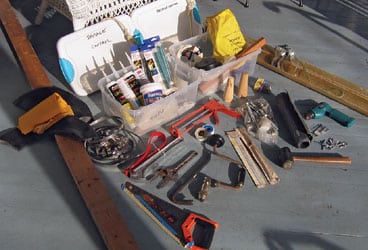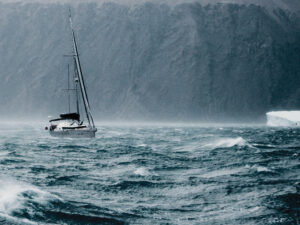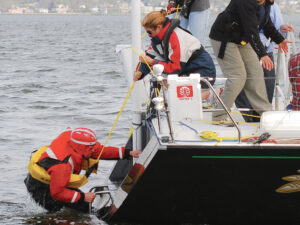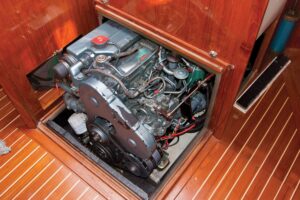
Prepping
For the last dozen years, I’ve campaigned my Express 37, Lora Ann, in numerous U.S. East Coast doublehanded regattas, including the Newport-Bermuda Race’s doublehanded class. Two-person offshore racing and shorthanded voyaging have much in common, and cruisers can learn a lot from the racing fleets, particularly when it comes to boat preparation and safety at sea.
What many sailors fail to do when organizing their safety program is ask, “What really works? How do we use the required equipment? What do I need that isn’t on the required list?” Test ideas, use your imagination to visualize emergencies, and develop effective plans supported by available equipment. Here I’ll describe what I’ve learned about safety harnesses, watch systems, and damage control.
Safety Harnesses
Since falls cause most sailing injuries, skilled and disciplined use of the safety harness and tether prevents tumbles, both on deck and in falls overboard. When sailing doublehanded, we’re tethered and clipped on 100 percent of the time. When racing with a full crew, we clip on with the tether at night, and we clip on during the day when conditions warrant. Some actions are always vulnerable, such as working on the bow and stern, moving around the steering wheel and traveler, and ascending and descending the companionway.
Jacklines to which safety-harness tethers are clipped should be made of Dacron or Spectra flat webbing, not rope or wire, which roll under your feet. When rigging our jacklines, we intentionally put in twists that raise its profile and make it easier to clip to. Jacklines should run down the center of the boat so your tether prevents you from falling over either side. This may be impractical, so the next best arrangement is to run them along the side decks.
People ask, “How do you walk wearing a tether?” It’s an important question. When Rich Wilson and I broke the sailing record from Hong Kong to New York on Great American II in 2003, Rich taught me to straddle the jackline while pulling up on the tether with one hand to make it taut, creating a stabilizing tripod effect. Ideally, you should have thigh or crotch straps on your combination harness/life jacket because a properly rigged strap keeps you from slipping out of the harness/life jacket when you’re in the water and enables you to float with your head well above water.
If they’re properly laid out, jacklines will keep you on the boat. Aboard Lora Ann, we secure the ends of the jacklines short of the bow and the stern. Forward, they end in the mid-foredeck area. This allows you to work the pulpit at the end of the tether, which protects you from falling over the bow if you slip or take a tumble. If you fall over a foredeck lifeline, this arrangement keeps you at deck level, not dragging in the water.
Aft, we secure the jackline at the most forward stanchion on the stern with a clove hitch, then cleat it on a stern cleat, and loop the remaining jackline across the transom to the opposite quarter. When doublehanding, I and my male crews pee into a bottle in the cockpit and pour it over the side, but on crewed boats, men tend to walk aft to relieve themselves. With the jackline system I’ve described, a man can stand at the after pulpit with his safety-harness tether taut, which prevents him from falling over the stern. If you were to fall over the side and be dragged aft, you wouldn’t be towed astern; you’d be level with the transom and so able to grab the loop across the transom. We also leave a spare tether hanging from the backstay so sailors can attach it to their safety harnesses and secure themselves to the boat. This tether is particularly important for doublehanders and cruising couples whose limited physical strength makes it difficult to pull the other sailor back on board.
Another big worry is falling while going below or coming back up through the companionway. This is an especially vulnerable movement when the boat is heeled and sailing in a rough seaway. Mounted on our bridgedeck is a big padeye with a strong strop that’s big enough to permit several tethers to be clipped in at the same time. Our doublehanded practice is to always clip our tethers into this strop before ascending or descending the companionway. Only when our feet are planted on the cabin sole do we detach the tether from the harness. We allow the tether to hang into the cabin, awaiting our return to the deck. This practice has become our religion when we’re sailing doublehanded.
Proper use of the safety harness, tether, and jacklines should eliminate the possibility of losing someone over the side. Nevertheless, all crews should often discuss and practice a crew-overboard procedure that works best on their boats.
Watch Systems
Racing sailors are very opinionated about watch systems. When racing, of course, the idea is to maximize performance at all times in the changing conditions. Though cruisers have different priorities, a discussion about watch systems on raceboats can offer cruising sailors some food for thought.
I hate systems that have everyone coming up or going down simultaneously. It’s impossible to get dressed or concentrate on speed, and these systems aren’t safe. When the traffic jam is over, the new crew on deck has lost all continuity, with reduced situational awareness. And it’s slow! You can watch a competitor’s bearing slide aft as the crew change their watch.
I don’t like the three-watch system of off/standby/on, although some high-performance big boats use it effectively. When I’m off watch, I like to shed my gear and climb into a bunk. Neither do I like dogging watches. I want my body to settle into one habit and not get tricked.
The only system for me is the simple four hours on/four hours off, except that every two hours, part of the watch goes down and part comes up. This staggered system provides continuity on deck while adding some change in companionship. The cabin is quieter during the change, and boat speed and tactics are maintained.
Damage Control
Oddly, it’s fun preparing for the catastrophes that you might encounter at sea. This brings home the sense of adventure that comes from being out there on your own against Mother Nature. You should assume that help isn’t available and that it’s you and you alone who must address the challenge and return to port without assistance. (Of course, cruising sailors need to carry requisite communications equipment and be prepared to use it in an absolutely worse-case scenario.) What I’m talking about here is more of a mindset: You must be prepared to deal successfully with the challenge. The late, great John Bonds—a skilled and passionate sailor who, with Cruising World and US Sailing, helped develop the popular Safety at Sea Seminars—put this best: “Prepare, prevent, prevail.”
The most demanding damage-control issue in ocean racing is emergency steering. During spring practice or on a shakedown cruise before making an ocean passage, go sailing with the emergency tiller to convince yourself that it’s both strong and effective. But what if the rudder or post breaks? The first problem might be flooding through the lower bearing. Every boat should carry a Forespar TruPlug, a 5-inch by 9-inch soft plug that can effectively seal any leak until more permanent repairs can be made.
Jury-rigged rudders made out of onboard junk are a joke. Most racing crews count on steering with a drogue, but even with practice, the best you can do is to steady the boat’s motion while waiting for assistance. For most boats, a broken rudder means abandoning your boat and getting on a rescue vessel.
Lora Ann‘s reverse transom precludes mounting a vertical rudder without adding a bulky stern frame, so we built a “trunk” between the cockpit floor and bottom of the hull into which we can slide an emergency rudder that breaks through a thin plate glued to the bottom. We’ve sailed with this rudder in 25 knots, and we believe that we could continue racing but not push the boat hard. Scanmar International offers a couple of interesting commercial products, the SOS Rudder and the M-Rud, that are also good alternatives for shorthanded voyagers looking for redundancy in their emergency-steering options.
Whether you’re getting ready for the Newport-Bermuda Race or for an extended cruise to the Caribbean, make sure your crew is involved in the planning, especially with regards to safety and damage control. In heavy weather or when things get dicey, having everyone vested and on the same page will pay off in spades.
Seasoned offshore sailor Richard du Moulin is a veteran of 22 Newport-Bermuda Races, four of which were winning efforts in the event’s doublehanded division.








